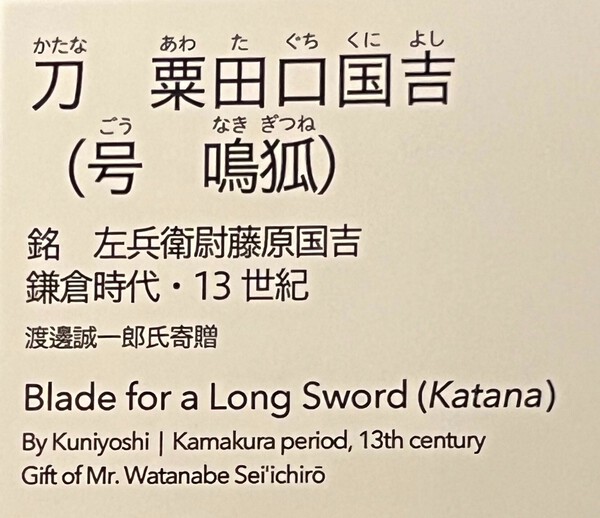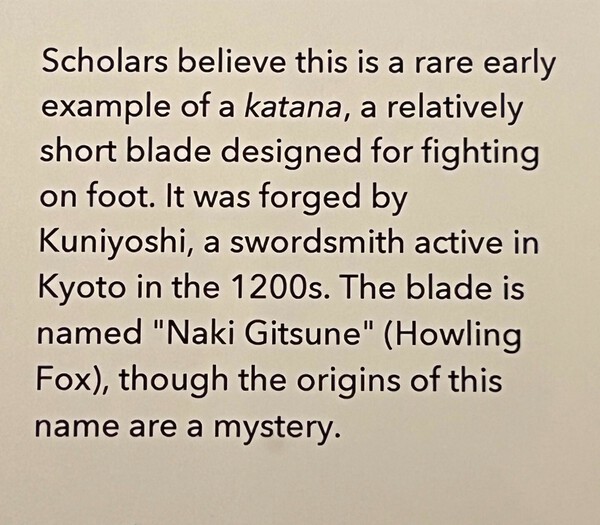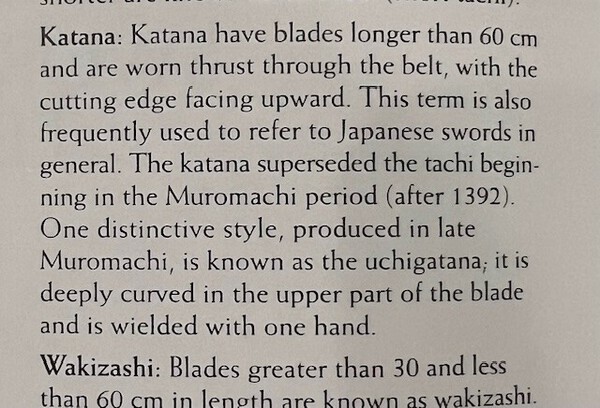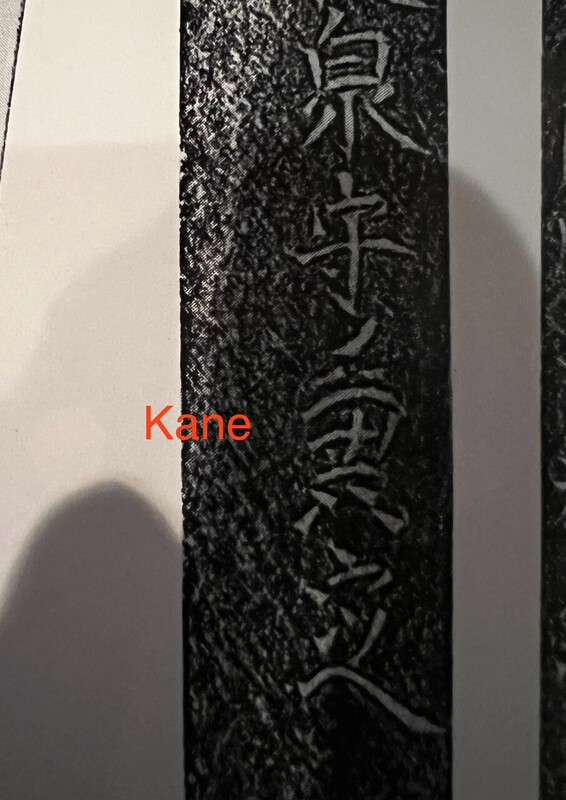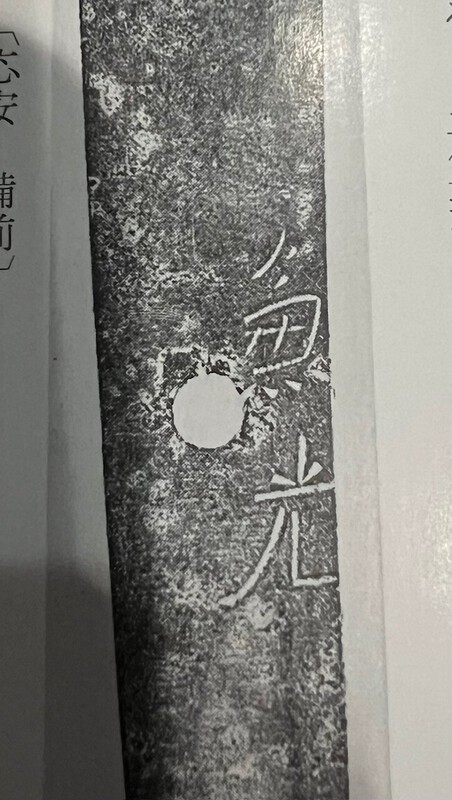-
Posts
1,785 -
Joined
-
Last visited
-
Days Won
43
Everything posted by Ed
-
Looking for some assistance on this mei. Fairly sure the left side reads Masahide, but the right side has me stumped. Any help greatly appreciated. Ed
-
Yes, Yagyu. The one seen on SF many years ago.
-

Tachi signed Uchigatana mei
Ed replied to Alexander Smith's topic in General Nihonto Related Discussion
Yes, Kamakura era as stated in my post. An early "uchigatana" prior to their reemergence in the Muromachi period. -

Las Vegas Sword Show Jan 26-27, 2024
Ed replied to Mark's topic in Sword Shows, Events, Community News and Legislation Issues
The room in the back is HUGE and wall to wall guns, edged weapons and more. -

Tachi signed Uchigatana mei
Ed replied to Alexander Smith's topic in General Nihonto Related Discussion
I recently saw the Kuniyoshi known as the "Nakigitsune" or Howling/crying fox. The BMFA shows a nagasa of 21.25", clearly wakizashi length. Yet, the card at the Tokyo National Museum calls it a katana, though here katana may be used generically for sword. Additionally the Boston catalog refers to it as "Crying" fox. TNM labels it as "Howling" Fox. It is this type of a lack of continuity which adds to confusion. -

Tachi signed Uchigatana mei
Ed replied to Alexander Smith's topic in General Nihonto Related Discussion
It can be somewhat confusing. Nagayama relates the the Katana of the Muromachi period had a nagasa of 70-73cm, while the "so-called" uchigatana from Bunki-Tenbun eras were about 60cm and no longer than 70cm. Sesko's references relate to earlier uchigatana being much shorter ie; sunnobi tanto or ko-wakizashi. So, most or all of these fell into either wakizashi or katana lengths, though some could have been mounted in tachi koshirae, even small tachi koshirae (ko-dachi < 60cm). Although katana mei vs tachi mei is a general guide for determining katana vs tachi, the most important criteria in calling a sword tachi or katana are the mounts. Prior to the muromachi period long swords were typically tachi. After that time, the katana came into it's own due to the change in battle field tactics. If you cut down a tachi and mount it in katana mounts, it is now a katana. Similarly, take a katana and mount it as a tachi, it's a tachi. How can this be? I hate to bring this up as it will only add to the confusion, but again keep in mind that that like most things in this hobby nothing is absolute. There were smiths who broke this rule (so to speak). There were smiths who made tachi yet signed on either side. Some which signed on the opposite side regularly. So, yes there were tachi, uchigatana, katana, wakizashi, tanto and other sub-types. It is likely the confusion surrounding so many variations is why the standards of katana, wakizashi and tanto were adopted. When did you last see a set of papers which said uchigatana, or sunnobi tanto. You may see blades called by these terms, and they may have been made that way, but the papers will not concur. You see a lot of short blades labeled as "sunnobi-Tanto" yet the NBTHK designation will say wakizashi based on the length criteria of the blade. Here is the first one I googled as an example. Listed as a Sunnobi Tanto, yet papered as a wakizashi: https://nihontoart.c...legant-edo-koshirae/ -

Tachi signed Uchigatana mei
Ed replied to Alexander Smith's topic in General Nihonto Related Discussion
From Sesko’s: uchigatana (打ち刀) When we consolidate all relecant early – that means Kamakura-period – entries like the Heike Monogatari (平家物語), Genpei Seisui Ki (源平盛衰記) oder Azuma Kagami (吾妻鏡), we come to the conclusion that an uchigatana was a shorter, simple mounted sword worn by lower ranking warriors or civil servants. The blade length measures somewhere between 1 shaku and 1 shaku 3 sun (30.3 ~ 39.4 cm). That means an early uchigatana was more like a later sunnobi-tantō or ko-wakizashi. katana (刀) – 1. Generic term for a blade measuring over 2 shaku (60.6 cm) in nagasa. 2. Colloquial term for an uchigatana (打刀). katana-mei (刀銘) – Signature of a sword that is chiselled on the sashi-omote side, i.e. the side facing away from the wearer when the blade is worn cutting-edge up thrusted through the belt. -

Tachi signed Uchigatana mei
Ed replied to Alexander Smith's topic in General Nihonto Related Discussion
The only absolute in this hobby is that nothing is absolute. There are references which relate varying views, dates, etc. These references varied several hundred years ago due to logistics and the lack of information being shared. From Sesko’s Encyclopedia of Japanese Swords: uchigatana (打ち刀) When we consolidate all relecant early – that means Kamakura-period – entries like the Heike Monogatari (平家物語), Genpei Seisui Ki (源平盛衰記) oder Azuma Kagami (吾妻鏡), we come to the conclusion that an uchigatana was a shorter, simple mounted sword worn by lower ranking warriors or civil servants. The blade length measures somewhere between 1 shaku and 1 shaku 3 sun (30.3 ~ 39.4 cm). That means an early uchigatana was more like a later sunnobi-tantō or ko-wakizashi. katana (刀) – 1. Generic term for a blade measuring over 2 shaku (60.6 cm) in nagasa. 2. Colloquial term for an uchigatana (打刀). katana-mei (刀銘) – Signature of a sword that is chiselled on the sashi-omote side, i.e. the side facing away from the wearer when the blade is worn cutting-edge up thrusted through the belt. From Nagayama: -
Several things: 1.) Mistakes are made by everyone at one time or another. The big difference is learning from those mistakes. Which is why books are recommended. Books enable you to do your own research and make an educated decision. Therefore eliminating the need to rely on others for help and reducing the probability of mistakes. 2.) The photo you provided is the date. Eisho something c. 1504. 3.) There were highly rated Sukesada. Hawleys rates the early Bizen Sukesada (Einin 1293-1299) at 125 pts. Later examples dated as your example is rated a mere 15pts. 4.) Don't buy into the hypothesis that a sword imported from Japan without papers is automatically gimei. Most of theJapanese dealers are buying at auction held in Japan only for licensed dealers. Most of the swords are unpapered when purchased. If a sword is considered potentially valuable and worth shinsa submission, it will likely be submitted, but not always due to costs of restoration and time constraints. I have imported many unpapered swords from Japan over the years which later went on to be papered by their new owners. Knowledge is key, research and study increase knowledge.
-

Tachi signed Uchigatana mei
Ed replied to Alexander Smith's topic in General Nihonto Related Discussion
Going about it the hard way, eh. -

Tachi signed Uchigatana mei
Ed replied to Alexander Smith's topic in General Nihonto Related Discussion
Not necessarily. While katana is the common and currently used term for uchigatana, they were not all long. uchigatana (打ち刀) The blade length measures somewhere between 1 shaku and 1 shaku 3 sun (30.3 ~ 39.4 cm). That means an early uchigatana was more like a later sunnobi-tantō or ko-wakizashi. If it is signed katana mei then it is not a Tachi but a Katana. -

Tachi signed Uchigatana mei
Ed replied to Alexander Smith's topic in General Nihonto Related Discussion
Stephen, That is what I was wondering, looks cut-off?? If so, how could it be called an uchigatana? He did mention the blade being "badly damaged". -

Tachi signed Uchigatana mei
Ed replied to Alexander Smith's topic in General Nihonto Related Discussion
There is Katana mei and Tachi mei. Your sword is signed katana mei. Uchigatana relates to a shorter sword such as an o-tanto or ko-wakizashi. They were in mounted in various fashion, katana or tachi koshirae, with or without tsuba, etc. Is this sword mounted? What is the nagasa? -
As pointed out, not every character will look identical. Keep in mind there were many smiths who signed Kanemitsu. There will be subtle differences between them much as the handwriting of 20 men today. Some smiths deliberately signed with a bit of artistic leeway to identify their particular works. In summary, not every character will be identical. Identifying them often comes from years of reading them. Here are a couple of oshigata photos which may help.
-
Not sure why you are posting again, your question was answered in 2007.
-
1,203,000¥ https://page.auction.../auction/u1117499616
-
Just a note: Number 6 is listed as ornamental plants. The plants depicted are "Ran" or grass orchids.
-
What sad news. Not only was he a forerunner in the world of English information when there was none, but he was just a downright nice guy. We used to talk about knives, especially bowies. He will be missed.
-
Yeah, buying any type of ivory is risky. I was almost caught up in a sting operation by the dept. of wildlife and fisheries over some walrus ivory. It resulted in my becoming very leery when buy anything which remotely looks like ivory.
-
Any individuals with Bronze Elephants, I am still looking.
-
Don't get me wrong, I appreciate the link. I have seen many of these bronze works over the decades, just never had much interest in collecting them. Thanks again, Ed
-
The first one posted is nice, but I do not think the tusks are original. They do say the tusks are "antler", so either my assumption is correct or they are attempting to bypass the Cites requirements. Either way could cause a sticky mess or worse, a loss of the item if caught up in customs. I do prefer original ivory tusks, the bronze ones do not have the same appeal. If the work of an all bronze piece was exceptional, I would consider them. The guy Sly is too high.
-
I'll check it out. Thanks, Ed
-
Looking for Meji period, or possibly other period Bronze elephants. The main criteria is that they are in excellent condition and have Ivory tusks. Thanks, Ed
-
These books average approximately $200 each.
- 1 reply
-
- 1
-




